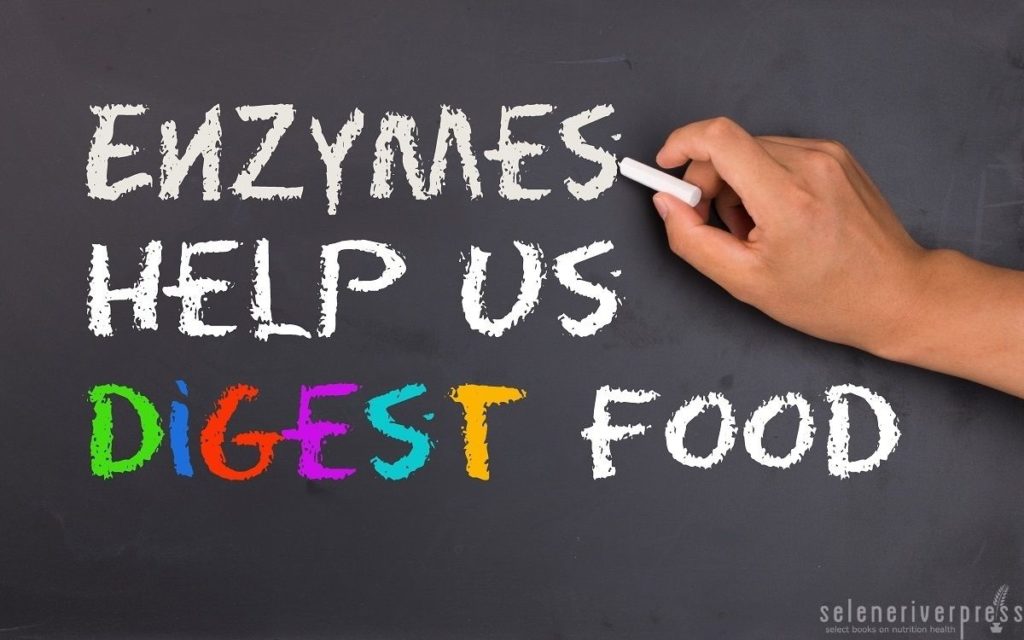Let’s assume that you’re an ordinary person living an ordinary life, eating what you believe is a healthy diet. Nevertheless, you still pop those antacids to relieve sometimes mild to severe digestive discomfort. And if you ever complain to your medical doctor about this issue, in most cases they simply hand you another prescription for something that will further strip your digestive system of essential stomach acids!
If this happened to me, I’d sure want to find out the root cause of the issue. One of the questions your doctor should be asking is how are you getting your enzymes? However, given that the consumption of enzymes is so rarely considered by doctors, I thought it might be a good subject to explore. After all, enzymes are not only associated with digestive issues but also numerous other health conditions, as I will discuss further into this blog post.
What Are Enzymes, and How Do They Work?
Let’s see how the website Very Well Health uses nonmedical language to describe the various types and functions of enzymes and how these amazing substances perform in our body:
“Digestive enzymes are substances secreted by the salivary glands and cells lining the stomach, pancreas, and small intestine to aid in the digestion of food.
“They do this by splitting the large, complex molecules that make up proteins, carbohydrates, and fats (macronutrients) into smaller ones, allowing the nutrients from these foods to be easily absorbed into the bloodstream and carried throughout the body.
“Digestive enzymes are released both in anticipation of eating, when we first smell and taste food, as well as throughout the digestive process. Some foods have naturally occurring digestive enzymes that contribute to the breakdown of certain specific nutrients.”
Examples of Specific Enzymes
Although there are thousands of different enzymes, some of which I address below, the website Medical News Today gathers some examples of specific enzymes. This list gives us a good idea of the essential role they play in the body:
- Lipases: A group of enzymes that help digest fats in the gut.
- Amylase: Found in saliva, amylase helps change starches into sugars.
- Maltase: Also found in saliva, maltase breaks the sugar maltose (found in foods such as potatoes, pasta, and beer) into glucose.
- Trypsin: Found in the small intestine, trypsin breaks proteins down into amino acids.
- Lactase: Breaks lactose, the sugar in milk, into glucose and galactose. Lactase is another enzyme found in the small intestine.
- Acetylcholinesterase: Breaks down the neurotransmitter acetylcholine in nerves and muscles.
- Helicase: Unravels DNA.
- DNA polymerase: Synthesizes DNA from deoxyribonucleotides.
The Amazing Number of Enzymes in a Human Cell
The website Enzyme Science discusses just how many enzymes are needed in the human body. Their enzyme FAQ page states the following (emphasis mine): “There are approximately 1,300 different enzymes found in the human cell. These enzymes can combine with coenzymes to form nearly 100,000 various chemicals that enable us to see, hear, feel, move, digest food, and think. Every organ, every tissue, and all the 100 trillion cells in our body depend upon the reactions of metabolic enzymes and their energy factor. Nutrition cannot be explained without describing the part that enzymes play.”
(Disclaimer: I do not approve of any enzyme product advertised on the websites cited in this post, which I reference for informational purposes only. Instead, I highly recommend getting enzymes primarily from food, possibly along with an enzyme supplement from Standard Process such as Zypan or Multizyme to help fill in the gaps, which I discuss below.)
Getting Enzymes from Fermented Food Sources
All traditional diets are high in enzymes and beneficial bacteria, explains Sally Fallon Morell (president of the Weston A. Price Foundation) in the Wise Traditions podcast “What’s So Good About Fermented Foods?” She further discusses what fermented foods are and how they are prepared; how we can incorporate them into our diet and introduce them to our children (as there is no such thing as too many ferments in the diet); how to choose the best kombucha; and which fermented foods are enjoyed in various regions of the world.
Getting Enzymes from Raw Food Sources
The website Cheese Slave explains how you can get an enzyme boost by including more raw foods in your diet. This article includes the following quote by Sally Fallon Morell and Mary G. Enig, writing for the Weston A. Price Organization (emphasis mine):
“Enzyme research has revealed the importance of raw foods in the diet. The enzymes in raw food help start the process of digestion and reduce the body’s need to produce digestive enzymes. All enzymes are deactivated at a wet-heat temperature of 118°F and a dry-heat temperature of about 150°F. It is one of those happy designs of nature that foods and liquids at 117°F can be touched without pain, but liquids over 118°F will burn. Thus, we have a built-in mechanism for determining whether or not the food we are eating still contains its enzyme content.
“A diet composed exclusively of cooked food puts a severe strain on the pancreas, drawing down its reserves, so to speak. If the pancreas is constantly overstimulated to produce enzymes that ought to be in foods, the result over time will be inhibited function.”
Dr. Royal Lee on Raw Potatoes
In his famous 1958 article “The Use of Raw Potatoes,” Dr. Royal Lee makes some interesting observations about raw potatoes and their enzymatic content. In his other work, he also advocates that 50 percent of our meals should be in the form of raw foods. This diet would include some of the great fermented foods I mention above.
I recommend reading this article in full at the SRP Historical Archives, but here is the introductory summary from Selene River Press:
“Dr. Royal Lee discusses the nutritional value of potatoes, explaining that much of that value is lost when they are cooked. ‘We may estimate that 25 percent of the vitamins are lost in cooking either by heat or leaching. The loss of vitamin C is particularly fast.’ In addition, he says that ‘the cooked potato contains no enzymes, as all enzymes are destroyed by heat.’ One such enzyme, studies showed, helps relieve constipation, while others are even more precious.
One of the enzymes found in raw potatoes is phosphatase, which promotes assimilation of calcium and iron in particular; another is tyrosinase, an essential component of the vitamin C complex and associated directly with the function of the adrenal glands.’ (Dr. Lee often referred to raw potatoes and raw mushrooms as the best food sources of tyrosinase available.) Lee gives tips on conserving potatoes’ nutrients when cooking them and instructs readers to be sure to add lemon juice to freshly extracted potato juice, which keeps the juice from oxidizing and turning black.”
Now, how about a recipe for raw potato salad? (And if you want to learn about some other great benefits of raw potatoes, I recommend reading my blog post “Resistant Starch Basics: The Health Benefits of Eating Raw Potatoes.”)
Raw Potato Salad 
Ingredients
1–2 medium organic red or white potatoes, unpeeled, washed and quartered lengthwise
1 teaspoon celery seed
2–3 small sour pickles, chopped
1 medium organic white, yellow, or red onion, thinly sliced
Homemade mayonnaise (see Nourishing Traditions) or organic store-bought mayonnaise, to taste, yet enough to cover ingredients
Celtic sea salt, to taste
Paprika, turmeric, or dry mustard, to taste
Instructions
- Using a fine slicer or food processor, thinly slice potatoes or chop them into bite-sized pieces. Place in a dish of cold water to prevent oxidation while preparing the remaining ingredients. When ready to add the additional ingredients, drain and pat dry with a paper towel.
- Add celery seed, sour pickles, and onion.
- Add mayonnaise and Celtic sea salt to taste. Marinate overnight in refrigerator.
- Before serving, sprinkle the top with paprika, turmeric, or dry mustard.
List of High-Enzymatic Foods
Now it’s time to put your thinking cap on and review this list of high-enzyme foods. You’ll find many wonderful foods that will help alleviate a good portion of the work done by your precious pancreas. You only have one—so don’t overwork it! (And please, eat your meat rare.)
[xyz-ihs snippet=”Begin-Authors-Note”]Afterthoughts from the Traditional Cook
Metamorphosis
Your transition is a miracle
A Divine orchestrated Oracle
Like the ever-changing caterpillar
Metamorphosed into a butterfly
Graceful and Beautiful
Bright and Colourful
Gracefully transforming its body
Spinning itself like a silky cocoon
For a season, it goes through pain
To renew the old nature again
Digesting and releasing enzymes
To dissolve all of its old tissues
It learns to creep and crawl
Then it learns to stand tall
Fashioned to fly and to soar
To kiss the beauty of a flower
He’s made us priest and kings
And He’s given you these wings
Spread these wings every day
And fly just like the butterfly
—“Metamorphosis” by Gideon Foli, 2020 (emphasis mine)
Disclaimer from Maria Atwood, CNHP: I am a Certified Natural Health Professional, CNHP, not a medical doctor. I do not diagnose, prescribe for, treat, or claim to prevent, mitigate, or cure any human diseases. Please see your medical doctor or health practitioner prior to following any recommendations I make in my blog posts or on my website.
Images from iStock/cacaroot (main), meteo021 (canned foods), karandaev (steak),






